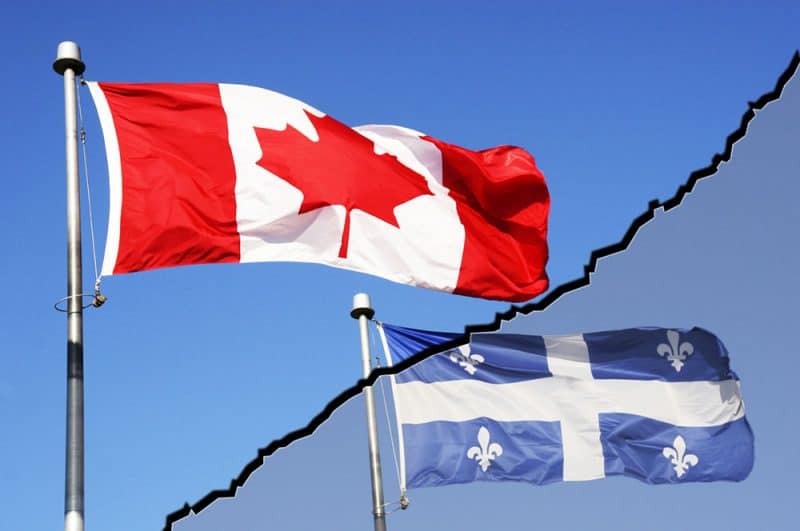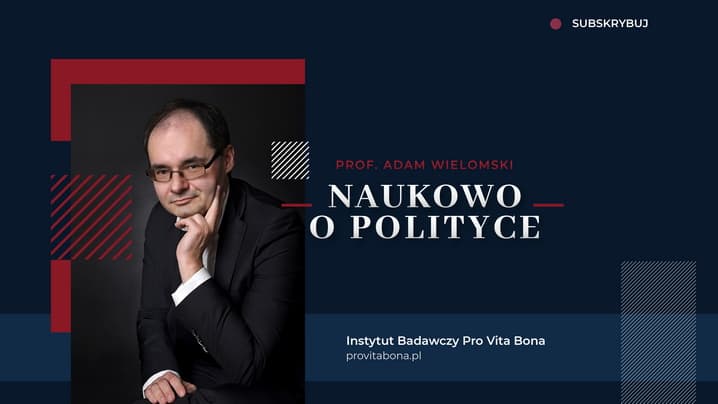(This article is partially based on an English-language text that appeared in Polish translation under the title, “Tendencje separatystyczne w Kanadzie.” (Separatist tendencies in Canada) trans. Olaf Swolkien, Nowe Sprawy Polityczne (New Political Affairs) (Wolomin, Poland) no 30 (2004-2005), pp. 77-81.)
Canada was founded as a State by the act of Confederation in 1867 (formally known as the British North America (BNA) Act, which was passed by the Parliament of Westminster in London) — out of the union of four pre-existent historical regions — Ontario, Quebec, Nova Scotia, and New Brunswick, which became the first four Provinces of Canada. It was also a union of two, long pre-existent historical nations – English (British) Canada and French Canada (Quebec). The Aboriginal peoples were included insofar as they had been traditionally considered to be under the special protection of the Crown.
While Prince Edward Island joined Confederation in 1873 (as a full province), the Western provinces of Manitoba, Alberta, Saskatchewan, and British Columbia entered Confederation in their present borders by 1905. To be precise, Manitoba and the North-West Territories joined Confederation in 1870, British Columbia in 1871, and the provinces of Alberta and Saskatchewan were created in 1905. Newfoundland remained a British Crown Colony (and had also been a self-governing Dominion of the British Empire) until 1949. The thinly-settled far-northern territories of the Yukon and the North-West Territories have remained under direct federal jurisdiction. However, in 1998, the semi-sovereign entity of Nunavut (the Inuit or Eskimo homeland) was created. It received a federal subsidy of $580 million dollars (Canadian) in its first year, and is likely to have to receive similar amounts of federal aid in the future.
Throughout the 1990s and today, militant Aboriginal activists have pushed toward semi-sovereignty or sovereignty for the former Indian reservation areas – while certainly not renouncing the billions of dollars of federal and provincial money that are going to Aboriginal peoples. Some critics have argued that the reason that conditions among Aboriginal peoples have not discernibly improved is that a coterie of Aboriginal leaders – while living extravagant lifestyles themselves – often does not pass on the various benefits to their group as a whole.
The main focus of separatist tendencies in Canada, however, has clearly been the province of Quebec. Lord Durham’s Report in 1840 had warned that the future of Canada might consist of “two nations warring in the bosom of a single state” – and that has largely happened. Until 1896, the powerful Macdonald-Cartier coalition of English-Canadian Conservatives and Quebec “Bleus” kept the country together well. However, in the 1896 federal election, the French-Canadians voted en masse for the federal Liberal Party.
In the Twentieth Century, the French-Canadians have mostly continued to vote for the Liberal Party in federal elections. By combining nearly every seat from Quebec, and a minority of seats from English Canada, the federal Liberal Party has hugely dominated Canadian federal politics. While mostly voting for the Liberal Party federally, at the provincial level in Quebec, the French-Canadians have often supported Quebec-nationalist parties, such the Union Nationale of Maurice Duplessis (who gave Quebec its current, distinctive flag in 1948) – and who represented an ultra-traditionalist, ultra-Catholic outlook.
In the early 1960s, the election of Liberals at the provincial level resulted in the so-called Quiet Revolution, where most of the hold of the Roman Catholic Church on French Quebec was removed. In a time of intellectual ferment and uncertainty, mostly left-wing-inspired anti-Canadian, Quebec-separatist tendencies, acquired some urgency. While mostly disdaining Quebec’s Roman Catholic past, the Quebec activists embraced a form of nationalism expressed mostly in the promotion of the French language, and in the economic struggle against the English who had largely dominated Quebec commercially. As the Quebec nationalists put it: “the social question is the national question.” The movement was galvanized by Charles de Gaulle’s 1967 pronouncement: “Vive le Quebec libre!”
In 1970, a small, violent Quebec separatist faction, the FLQ (which had murdered a Quebec Minister and kidnapped a British diplomat) was suppressed by the declaration of the War Measures Act (martial law) by Canadian Prime Minister Pierre Elliott Trudeau.
While Trudeau claimed to have successfully resisted the threat of Quebec separatism, he had his own, left-liberal agenda to promote. With the continued assurance of federal Liberal supremacy in Quebec, Trudeau obtained what he (possibly vaguely inspired by the Maoist theory of building up a “provincial stronghold” for the eventual conquest of China) considered a “regional base for socialism.” Indeed, Trudeau won the majority of seats in English-speaking Canada only in the 1968 election, when “Trudeaumania” swept the country. Nevertheless, Trudeau remained in power from 1968-1984 (except for nine months in 1979-1980). He realized that in the Canadian system as it existed at that time, a Prime Minister who continued to win majority governments could do virtually anything he wanted. Trudeau was also assisted by the federal New Democratic Party (Canada’s extremely ideologically-energetic social democrats) – a party he himself had earlier belonged to. Trudeau was extremely conscious of using all the instruments and powers at the disposal of a government and state to strongly shape society.
In Quebec itself, Trudeau battled against the separatist Parti Quebecois, which had arisen as a new focus for Quebec aspirations. In 1980, the Parti Quebecois (under the leadership of Premier Rene Levesque), which had won the 1976 election in Quebec, held a referendum on “sovereignty-association” – which was defeated by a ratio of about 60-40. In 1982, Trudeau brought the Charter of Rights and Freedoms into the Canadian Constitution, which was opposed by Rene Levesque and the PQ – who saw it as diluting Quebec’s “collective rights.”
The Charter of Rights and Freedoms essentially enshrined nearly all of Trudeau’s agenda – including bilingualism, multiculturalism, feminism, affirmative-action policies (called employment equity in Canada), transfer payments from richer to poorer provinces — as the highest law of the land.
In 1984, many Quebecois nationalists, now disgusted with Trudeau, aligned themselves with the Progressive Conservative party of Brian Mulroney, who was himself a fluently bilingual Quebecker. Mulroney won one of the largest parliamentary majorities in Canadian history. However, in the aftermath of sixteen years of Trudeau, enormous drive and energy would have been required to initiate a process of recovery from the “Trudeau revolution.” Though he had allowed the aura of a right-winger to settle on him in 1983-1984, Mulroney was himself mostly driven by liberal sentiments, and – once in power — he brutally kept down “small-c conservative” elements and ideas within the Progressive Conservative party.
In 1987, Mulroney reached the Meech Lake Accord with the provincial premiers. Quebec, under Liberal Premier Robert Bourassa, agreed to accede to the Charter of Rights and Freedoms, in exchange for further modifications to the Constitution, which would – among other provisions — recognize Quebec as a “distinct society.” The Meech Lake Accord was well on its way to acceptance, but a disparate coalition of Trudeau Liberals and right-wing English-Canadians disdainful of Quebec managed to torpedo the Accord, when two smaller English-Canadian provinces withheld their approval. In 1992, Mulroney tried again with the Charlottetown Agreements, which were put to a countrywide referendum. Ironically, the Quebecois nationalists rejected the Charlottetown Agreements because they felt they gave them “too little,” whereas English Canada felt the agreements gave Quebec “too much.”
It was virtually a direct consequence of the failure of the Charlottetown Agreements that the Bloc Quebecois – under the leadership of Lucien Bouchard, Mulroney’s former Quebec lieutenant — arose to contest the federal election of 1993 (running candidates only in Quebec), and the Parti Quebecois won the Quebec provincial election of 1994. Jacques Parizeau’s Parti Québécois won the September 1994 provincial election with about two-thirds of the seats (but with only a fraction more of the popular vote, with the „first-past-the-post” system of geographically-based ridings). In 1995, there was the second referendum on Quebec sovereignty, which failed by a razor-thin margin. Jacques Parizeau’s bitter concession speech, blaming the defeat on “money and the ethnic vote” was slapped down – even by some prominent members of his own party — as virtually symptomatic of “Nazism” – and he was forced to resign from the PQ leadership.
The Bloc Quebecois won 54 seats in the federal election of 1993, thus becoming the Official Opposition (the second-largest party) in the federal Parliament. Preston Manning’s Reform Party – which had arisen in 1987 as a Western Canadian regionalist and “small-c conservative” alternative — won 52 seats, whereas the Progressive Conservatives (under the leadership of Kim Campbell) were reduced to 2 (two) seats!
In the 1997 federal election, the BQ won 44 seats, but the Reform Party became the Official Opposition, with 60 seats (all of its seats won in Western Canada).
In the 2000 federal election, the BQ won 38 seats, with the Canadian Alliance (which had emerged out of the broadening of the Reform Party) winning 66 seats (64 in Western Canada, and two in Ontario).
In 2003, the Parti Quebecois government was decisively defeated by the Liberal Party in Quebec, which gave the impression that separatism was ebbing.
However, the fortunes of the Bloc Quebecois revived in time for the federal election of June 28, 2004, partly in reaction to the federal sponsorship scandal, where at least 100 million dollars (Canadian) had gone to Quebec Liberal Party cronies. The Bloc Quebecois won 54 seats. The rest of Quebec’s 75 seats went to the Liberals. The Conservative Party – which was reconstituted in December 2003 out of the merger of the Canadian Alliance and the “ultra-moderate” federal Progressive Conservatives — at that time had a minimal presence in Quebec.
However, in the 2006 and 2008 federal elections, the Conservative Party was able to win 10 seats in Quebec – while the BQ continued to hold most Quebec seats.
However, the federal election of May 2, 2011 marked major change. While the Conservatives managed to win five seats in Quebec, the BQ was annihilated down to four seats, with 59 seats won by the NDP! Quebec, which has a bit of a reputation for doing the unexpected, had pulled off another surprise.
Quebec today is largely defined by its modern Quebecois nationalism, an outlook that mixes traditionalism and progressivism. It is especially “progressive” in its secularism, in its virtual repudiation of the Roman Catholic traditions of Quebec, which had been considered almost definitional of Quebecois identity for most of Quebec’s history. Today, Québec separatism to some extent appears to be waning. One of the reasons for the apparent waning of separatism is that Québec is simply being flooded with all kinds of economic benefits to persuade it to remain in Canada, a process that has been ongoing for at least four decades. At least some “non-separatist nationalists” feel that the Québécois are already maîtres chez nous („masters in our own house”).
In late 2011, there arose a new political grouping on the Quebec provincial scene. This was the Coalition for the Future of Quebec (Coalition pour l’avenir du Quebec) (CAQ), led by Francois Legault and Charles Sirois (a prominent businessman). It polled surprisingly well for a new party. It said that the issue of sovereignty should be downplayed. Rather, the CAQ offered efficient management of the economy – calling itself “le gauche efficace” – the “efficient Left”. The ADQ (Action democratique du Quebec) which had been reduced down to 6 seats in the Quebec provincial election of December 8, 2008, readily dissolved itself, in favor of joining the CAQ. In the prior 2007 provincial election, the ADQ had become the Official Opposition to the Liberals, winning 41 seats, while the PQ had come in third. The ADQ was a smaller, centre-right party, that had arisen only in the 1990s.
In the September 4, 2012 election, the PQ won 54 seats, the Liberals, 50, and the CAQ, 19. The very left-wing as well as separatist Quebec solidaire won 2 seats. A minority PQ government was formed.
The results of the provincial election in Quebec on April 7, 2014, were somewhat unexpected. It was a huge win for the Liberals, led by Philippe Couillard, who won 70 seats. The Parti Quebecois was crushed, winning only 30 seats. The Coalition Avenir Quebec (CAQ) won 22 seats, while the left-wing Quebec solidaire, won 3. Since a strong majority was won, this means that an election is unlikely to occur for at least four years.
One of today’s ironies is the fact that secularization and modernization have given Québec one of Canada’s lowest birthrates and highest abortion rates — creating a demographic crisis in a society once known for its very large families, and for its so-called „revenge of the cradle” against the English. It could be argued that Québécois nationalists will have to re-evaluate their relationships to what is called “the rest of Canada” (TROC), to their own traditionalist past, and to the massive inflow of Third World immigration into Québec, if they are indeed seriously interested in their survival as a nation over the coming centuries.
Outside Quebec, separatism has never been a major tendency. Although the Western Canadian province of Alberta, and Western Canada in general, has felt a great deal of alienation from so-called “Central Canada” (i.e., Ontario and Quebec), its dissent has rarely taken the form of outright separatism. There were indeed small marginal parties calling for a “Western Federation” – but anti-federalist sentiment in the West mostly took the form of the Reform Party – a party which existed only at the federal level and hoped to win power in Ottawa in order to change the federal system.
Although there have been occasional expressions of separatist feelings in the Atlantic region, the Atlantic provinces are recipients of large amounts of federal aid, and as a result are rather strongly in favour of the federal government.
During the period of the right-leaning Mike Harris government in Ontario (1995-2002), there was some talk among the Left, which largely dominates the city of Toronto, that Toronto should secede from Ontario, and be recognized as Canada’s “eleventh province.” However, once the Liberal Party won the Ontario election in 2003, this talk has mostly subsided. Now that the P.C.s have again won a majority in Ontario, talk of Toronto separatism has revived.
It is unlikely that such large immigrant groups as the Chinese or the South Asians are going to seek separatist solutions – they are more likely to work within the federal system for their own benefit. However, the claims of some Muslim immigrants for instituting shari’a law in Canada could be seen as amounting to a non-territorial separatism.
It could be argued that the federal government has today mostly become a vehicle for regnant left-liberalism in Canada. For example, Canada was the third country in the world (after Holland and Belgium) to recognize “same-sex marriage.” It could be argued that some kind of “regionalization” or “provincialization” or “cantonization” may be the most natural solution to Canada’s various separatist and regionalist dilemmas – where the provinces or regions would have jurisdiction over most issues at the local level. Stephen Harper’s brief talk about “Belgian-style federalism” and the sentiments once expressed by Mario Dumont, the former leader of the ADQ — that he would want Quebec to be called “the autonomous state of Quebec” may be attempts – however clumsy – to try to give voice to a “regionalist scenario” future for Canada. Gilles Duceppe, the longtime leader of the BQ – though blatantly ignoring the reality of the new European “superstate” – had also invoked the older European Common Market idea of an “economic union of sovereign states” as a possible model for the Americas.
Since Harper’s Conservative majority in Ottawa manifestly failed to make headway in enacting major reforms of the Canadian system, devolutionist scenarios will likely make an appearance among disenchanted Conservative voters. Ironically, increased decentralization is probably what the Quebec nationalists want as well, so these scenarios may point the way to a path where Canada might actually become a more “rooted” federation in its constituent parts.
Mark Wegierski



